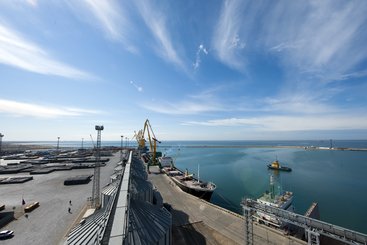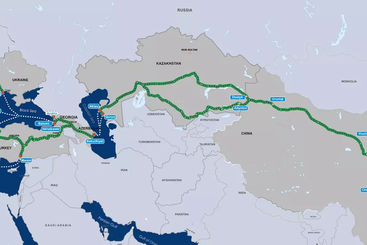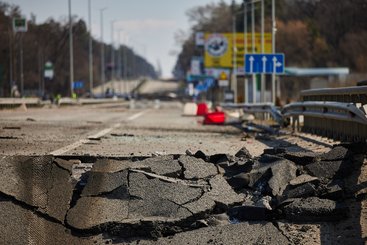The Middle Corridor is rapidly gaining popularity as an alternative trade route, especially in light of geopolitical developments. This emerging trade corridor provides an alternative to the well-established Northern Corridor (a transport corridor connecting Europe and Asia through Russia), specifically offering shorter distance, access to untapped markets and potential for growth.
However, addressing infrastructure challenges and securing investment will be key to ensuring the Middle Corridor's long-term success and competitiveness in the world of international trade. The Corridor represents an opportunity for participating countries as they seek to reduce their trade dependency on a limited number of key export partners and on largely low complexity commodity export baskets.
Shortening distances, expanding horizons
The Middle Corridor is a multimodal land and sea transport corridor that facilitates the movement of products utilising a combination of rail and sea transportation. It represents the shortest path for goods traded from China to Europe, crossing through Central Asia, the Caspian Sea and extending into the South Caucasus and Turkey before reaching Europe. One of the most significant advantages of the Middle Corridor is its shorter total length of which is approximately 3,000km less than Russia's Northern Corridor. This route not only reduces transit times, but also addresses sanctions-compliance issues by bypassing Russia; this makes it an attractive option for businesses seeking new trade routes and markets.
The Middle Corridor experienced a remarkable increase in cargo transit volume, totalling 1.9 million tonnes in the first nine months of 2023 (89% year on year increase from the same period in 2022). This set a record for freight volume on the Corridor and underscored its growth potential to meet the rising demands of global trade. One of the examples of the use of the Corridor is the introduction of a new route from China to Europe by the Finnish transportation company Nurminen Logistics in May 2022, which was met with strong demand.
The capacity of the Middle Corridor, which currently stands at 5.8 million tonnes annually, is significantly less than that of the Northern Corridor, but its capacity will rise if the right measures are implemented. Recently, the World Bank published an economic analysis on the potential of the Middle Corridor to develop over the next decade, which estimates that by 2030, travel times between the western border of China and Europe will halve, and freight volumes will triple to 11 million tonnes.
Challenges
Despite the considerable progress in the development of the Corridor, operational inefficiencies and high costs are limiting factors in the realisation of its full potential, leading operators to revert to sea routes. The Corridor is subject to unpredictable delays, which may vary from 14 days to 45 days, but can take up to 60 days depending on the circumstances.
Practical challenges include a lack of operational efficiency due to ports operating below their capacity, as well as poor railway infrastructure. A lack of coordination between operators along the route was the most frequently cited problem, but it seems likely to be solved with the introduction of a single operator. The most prominent concern lies in the lack of proper infrastructure for oil and gas transportation, particularly in the Caspian and Trans-Caspian regions.
A prime example of this challenge is the transportation of oil from Kazakhstan to Azerbaijan via the Middle Corridor, which involves multiple transshipment steps. Oil is first transported to Kazakhstan's Kuryk or Aktau Port via railway, where it is unloaded and reloaded onto a vessel and transferred to Baku. From Baku, it is once again loaded onto a train and transported to a pipeline for further distribution. This complex process results in significant delays and technical difficulties, contrast to the ease of routes through Russia via the Caspian Pipeline Consortium (CPC).
Investment imperatives
To fully unlock the potential of the Middle Corridor, substantial investments in infrastructure are imperative. Upgrading the Caspian and Trans-Caspian infrastructure for oil and gas transportation, as well as improving the overall efficiency of the Corridor, is essential. With the promise of shorter transit times, access to new markets and increased business opportunities, the Middle Corridor presents an attractive option for investors and governments looking to bolster trade and economic growth in the region.
According to the latest research by EBRD, the investment needed for Middle Corridor infrastructure upgrades are estimated to be in the region of €18.5 billion. Priority areas for investment relate to: rail and road network rehabilitation and modernisation; rolling stock expansion; port capacity enhancements; and improvements to border crossing points, multimodal logistics centres and auxiliary network connections across participating countries. Investment should take into account the needs, priorities, capacities and specific conditions of the participating countries.
Opportunities for economic development
Due to limited capacity, the Middle Corridor is not expected to replace the Northern Corridor, but it presents an opportunity for trade diversification for countries along the route. Even though the impetus for using the Middle Corridor is currently driven by geopolitics (i.e. the desire to avoid the Northern Corridor), the development of the Corridor presents opportunities for economic development in participating countries. If we look at the industrial structure of the participating countries, most of them are raw materials exporters (e.g. oil producing Kazakhstan and Azerbaijan). It is strategically important for these countries to increase the export competitiveness of their value added goods and to promote the industrial development of domestic enterprises to compete with potential increases in import flows. In order to fully utilise the increased connectivity brought about by the Corridor, participating nation’s governments should use export promotion strategies and global value chain linkages to link their domestic SMEs to larger corporations.
What to watch
As the Middle Corridor gains traction as a geopolitical response to circumvent traditional routes, its economic potential becomes increasingly apparent. Shorter distances, access to untapped markets, and the promise of growth make it an attractive prospect for businesses and governments alike. However, success hinges on addressing infrastructure challenges and securing the necessary investments. The geoeconomic significance of the Middle Corridor represents a pivotal chapter in the unfolding narrative of international trade, offering participating countries an opportunity to reshape their trade dependencies and foster sustainable economic development.



